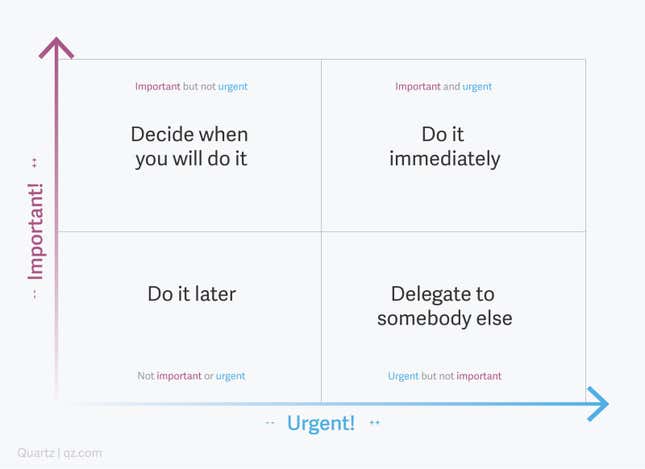Most workdays start with the right intentions. You begin the day energized, with an ambitious list of tasks and a manageable inbox. But things quickly unravel as meetings, email, and colleagues’ fire drills take over. Before you know it, your deliberate organization comes crashing down like an overextended Jenga tower, sending you home defeated.
Don’t despair. The cycle can be broken and your good intentions can be rescued through prioritization, focus, and tapping into a resource that isn’t finite, even if it sometimes feels as though it is: your energy. Here’s everything you need to know about structuring your work day:
Choose the right things to work on
There’s a simple 2×2 matrix named after US president Dwight Eisenhower that can help you prioritize. As the former five-star general famously proclaimed: “I have two kinds of problems, the urgent and the important. The urgent are not important, and the important are never urgent.” You’ve probably treated tasks in your to-do list as “urgent” or “important” with little regard to the difference between them. The Eisenhower matrix will show you how and why you should be distinguishing the two.
The matrix consists of four boxes, with the horizontal axis representing “urgency” and the vertical axis representing “importance.” If you spend a few minutes categorizing each of your tasks into the appropriate box, you may notice that you’re spending time on the wrong activities.

Urgent but Not Important tasks tend to produce a lot of anxiety. They include things like messages from colleagues and acquaintances asking to schedule meetings or respond to FYIs. These are the tasks that put us into constant “reply mode.”
And this is what detracts from our most important tasks, the Important, but Not Urgent. These tasks typically lack deadlines, which makes it tempting to hit the snooze button on them. For leaders, they can include working on strategic goals, long-term planning, investing in talent, and building a brand. Can you imagine the repercussions of delaying these indefinitely?
Further Reading
The Simple System that Helped me Stop Obsessing over Work - and Start Prioritizing my Family
Block out chunks of time for Deep Work
Venture capitalist Sam Altman has called Digital Distraction “one of the great mental health crises of our time.” We check our smartphones 150 times a day (on average) and according to computer science professor Cal Newport, this significantly impairs our ability to think clearly and creatively.
Newport believes that the remedy is Deep Work, maximizing the intensity of work per unit of time. He cites one of the tactics used by University of Pennsylvania professor Adam Grant, the “batching of hard but important intellectual work into long, uninterrupted stretches.” For Grant, this means dedicating the autumn semester to teaching and spring and summer to research. At a micro level he alternates between having his door open to students and completely isolating himself (including turning on his out-of-office responder) for discrete research tasks.
If your job doesn’t allow you to front-load all of your work to one semester, don’t despair. To do Deep Work, Newport recommends fixed-schedule productivity which entails creating (and vigorously protecting) a schedule that “provides the ideal balance of effort and relaxation.” For him, this also means not working past 5:30 pm. And if that doesn’t work, you might consider a lighter-weight version of Deep Work, the 25-minute Pomodoro, repeating cycles of 25 minute bursts of work followed by a short break.
Further Reading
Deep Work: The Secret to Achieving Peak Productivity
Mind the cost of meetings
Paul Graham, co-founder of startup incubator Y Combinator, distinguishes between two types of schedules: the maker schedule and the manager schedule. If you alternate between meetings, conference calls, and email, you’re likely on a manager schedule. Managers tend to organize their days in one-hour blocks of time. By default they “change what [they’re] doing every hour.” Makers tend to be creators such as writers, programmers, and artists. Their work requires long stretches of uninterrupted time.
Makers’ and managers’ schedules tend to intersect at meetings, and both types of people should understand the ramifications of these get-togethers. Even a short meeting can have a cascading effect, whether it’s forcing you to switch contexts or preventing you from beginning an ambitious project because you know that a mid-day interruption awaits. We should always be asking ourselves, “Is this meeting necessary?”
Further Reading
Maker's Schedule, Manager's Schedule
Tap into a secret resource: your energy
Now for some good news. There’s a new time management tool in town: it’s your energy. And unlike time, which is finite, energy can be replenished. Yet most productivity advice centers around extracting efficiency instead of replenishing this resource.
The seminal work on the replenishment approach is Tony Schwartz and Jim Loehr’s book The Power of Full Engagement, which argues that to get the most out of people you must strengthen and replenish their physical, mental, emotional, and spiritual energy. Each of these categories deserves its own section, but fundamentally it’s about recognizing that employees are not a type of person, they are people. Workplaces and managers can support their colleagues’ physical energy through attitudes and policies around nutrition, fitness, and sleep; emotional energy by helping them manage their fight-or-flight stress response; and mental energy by giving helping them focus on the tasks with the most long-term leverage. As for spiritual energy, people who find meaning in their work are more likely feel more positive energy, focus better, and demonstrate greater perseverance – but that’s got to come from the top of an organization.
Further Reading
Embracing our Humanness to Increase Productivity
Eat that frog!
Have you ever had that dreaded task that seems to linger on your to-do list, hanging over your productivity potential like a dark cloud? That task is the proverbial frog and one should try to eat it as early as possible each day.
The habit of immediately tackling this most important task will help you notch a win early in the day and for many people it will harness our best and most productive energy. Completing this task will have a compounding effect on your day by removing a large cognitive overhang while also giving you momentum for the rest of your day.
Once you’ve swallowed the frog, it’s time to knock out the rest of your task list. Start by asking yourself this important question: What is the most valuable use of my time right now?
Further Reading
Eat that frog - do your most important tasks in the morning
These four strategies should help you reclaim control of your day and focus on the most important tasks at hand. President Eisenhower would approve.
Find more Quartz At Work guides here.
